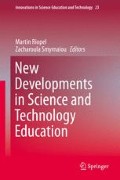Abstract
Schools sometimes have to address many contemporary challenges simultaneously. In the Quebec province (Canada), a new competency-based state curriculum in science and technology, the integration of ICT and new collaborative pedagogical methods are some of these challenges to be addressed. This situation leads us to radically reconsider the way we design learning environments and select our teaching methods. That is the conclusion that was made at Dalbé-Viau High School (Québec) and led us to design a collaborative educational learning environment called PEAi (Programme d’Enrichissement des Apprentissages Informatiques).
For three years now, Dalbé-Viau High School designs and develops, improves and sustains such learning environments that are based on collaboration among high school students. Each of these classes contains six interactive whiteboards facing work islands of 4 or 5 students with a laptop for each.
Learning science is done through challenges, problems and projects. To address these challenges and solve these problems, students use computer tools that are at their disposal (computers, interactive whiteboards, the Internet, cameras, etc.) and through discussion and interaction. This collaboration between team members is however the central characteristic of the learning environment. Indeed, it allows them to confront their initial conceptions and sometimes produces the productive uncertainty that is needed for learning and for the validation of their understanding.
Access this chapter
Tax calculation will be finalised at checkout
Purchases are for personal use only
References
Akinbobola, A. O. (2009). Enhancing students’ attitude towards Nigerian senior secondary school physics through the use of cooperative, competitive and individualistic learning strategies. Australian Journal of Teacher Education, 34(1), 1.
Astin, A. W. (1993). What matters in college?: Four critical years revisited (Vol. 1). San Francisco: Jossey-Bass.
Baudrit, A. (2007). L’apprentissage collaboratif: plus qu'une méthode collective? Bruxelles: De Boeck Université.
Beichner, R. J, Saul, J. M, Abbott, D. S., Morse, J., Deardorff, D., Allain, R. J, . . . Risley, J. S. (2007). The student-centered activities for large enrollment undergraduate programs (SCALE-UP) project. Research-Based Reform of University Physics, 1(1), 2–39.
Dillenbourg, P. (1999). What do you mean by collaborative learning? In P. Dillenbourg (Ed.), Collaborative-learning: Cognitive and computational approaches (pp. 1–19). Oxford: Elsevier.
Fourgous, J.-M. (2012). Apprendre autrement» à l’ère du numérique. Rapport de mission parlementaire.
Hake, R. R. (1992). Socratic pedagogy in the introductory physics laboratory. The Physics Teacher, 30, 546–552.
Hayes, D. N. A. (2007). ICT and learning: Lessons from Australian classrooms. Computers & Education, 49(2), 385–395.
Karsenti, T. (2003). Favoriser la motivation et la réussite en contexte scolaire: Les TIC feront-elles mouche. Vie pédagogique, 127, 27–32.
Karsenti, T., & Collin, S. (2013). Avantages et défis inhérents à l'usage des ordinateurs portables au primaire et au secondaire. Éducation et francophonie, 41(1).
Lagrange, J.-B. (2000). L’intégration d’instruments informatiques dans l’enseignement: une approche par les techniques. Educational Studies in Mathematics, 43(1), 1–30.
Matchinda, B. (2008). 14. Les TIC, l’apprentissage et la motivation des filles et des garçons au secondaire au Cameroun.
Moll, M. (1997). Information technology in the classroom: Pits and pendulum – A Poe-esian look at planning. Education Canada, 37(1), 6–9. 23.
Van Boxtel, C. (2000). Collaborative concept learning. Unpublished PhD dissertation, University of Twente, Enschede.
Author information
Authors and Affiliations
Corresponding author
Editor information
Editors and Affiliations
Rights and permissions
Copyright information
© 2016 Springer International Publishing Switzerland
About this chapter
Cite this chapter
Durocher, É. (2016). Learning Science in a Collaborative and Technological Environment. In: Riopel, M., Smyrnaiou, Z. (eds) New Developments in Science and Technology Education. Innovations in Science Education and Technology, vol 23. Springer, Cham. https://doi.org/10.1007/978-3-319-22933-1_2
Download citation
DOI: https://doi.org/10.1007/978-3-319-22933-1_2
Published:
Publisher Name: Springer, Cham
Print ISBN: 978-3-319-22932-4
Online ISBN: 978-3-319-22933-1
eBook Packages: EducationEducation (R0)

